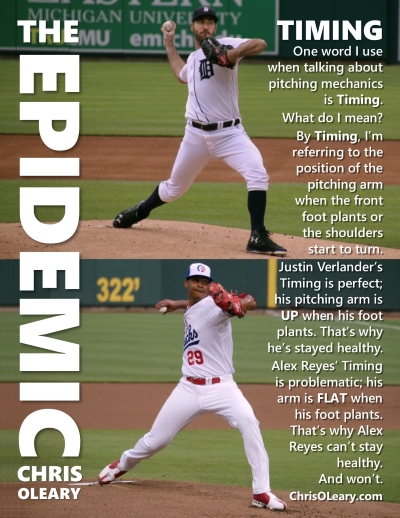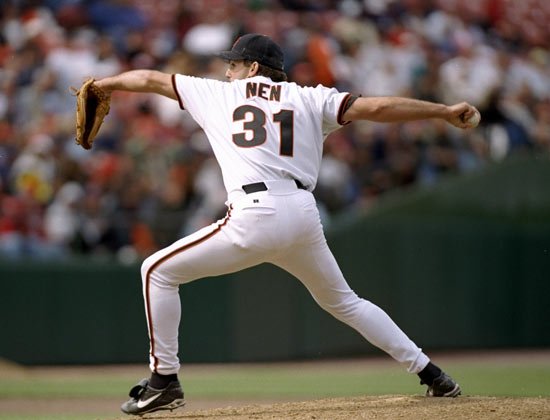 Timing in baseball pitchers refers to the position of the pitching arm when the pitcher's pitching arm starts to come under load, which is often but not always -- and, thanks to Driveline, less and less so -- at front Foot Plant. When he was in his prime, with Detroit, Justin Verlander's Timing was perfect; his pitching arm was UP when his front foot plants. That's why he stayed healthy. In contrast, Alex Reyes' Timing is problematic; his arm is FLAT when his front foot plants. That's why Alex Reyes can't stay healthy.
Timing in baseball pitchers refers to the position of the pitching arm when the pitcher's pitching arm starts to come under load, which is often but not always -- and, thanks to Driveline, less and less so -- at front Foot Plant. When he was in his prime, with Detroit, Justin Verlander's Timing was perfect; his pitching arm was UP when his front foot plants. That's why he stayed healthy. In contrast, Alex Reyes' Timing is problematic; his arm is FLAT when his front foot plants. That's why Alex Reyes can't stay healthy.
And won't.
Timing in Baseball Pitchers
In general, when it comes to Timing and pitching mechanics...
- UP = GOOD = ON TIME: In pitchers with GOOD Timing, when their shoulders start to turn, their pitching arm is UP.
- FLAT = BAD = LATE: In pitchers with BAD Timing -- whose arms are LATE -- their pitching arm is FLAT when their shoulders start to turn.
Modern pitchers throw harder at younger ages, but get hurt more often, because their Timing is worse; their arms are flatter, when their shoulders start to turn, than pitchers of the past.
While some differences in baseball pitchers' Timing arise naturally, increasingly these differences are the result of the use of any number of tricks and shortcuts that pitching coaches are employing -- often in an effort to deliver quick and easy increases in pitchers' velocity -- that work by creating Timing problems.
A Note on Judging Timing
In judging Timing, I used to look at front foot PLANT -- not, and never, front foot STRIKE -- because that was pretty reliably when the shoulders started to turn. No longer. Now, because of Driveline's Positive Disconnection idea, that is no longer the case; now, there's less and less relationship between when the front foot PLANTS and the shoulders start to turn. As a result, I'm in the process of updating my terminology to consistently say "when the shoulders start to turn," because that is what I look at, now, when judging Timing.
Why do Pitchers get hurt?
Why are pitchers getting hurt and more often?
Recent research suggests the answer to both of those questions is the same.
When I talk about Timing in baseball pitchers, I am talking about the position of the pitching arm when the pitcher's front foot plants or their shoulders start to rotate.
Technically speaking, by "position" I am referring to the amount of External Rotation of the pitching arm.
You can see the difference in pitchers' Timing by comparing and contrasting the position of the pitching arms of durable pitchers like Tom Seaver and Nolan Ryan and injury-plagued pitchers like Matt Harvey and Jose Fernandez at foot plant.

Examples of Timing in Baseball Pitchers
As I explain in my piece on Flat Arm Syndrome, the pitching arms of more durable pitchers tend to be more UP at foot plant while the pitching arms of less durable pitchers tend to be more FLAT -- or late -- when their shoulders start rotating.

Justin Verlander
Justin Verlander is an example of an active pitcher who consistently demonstrates superior Timing; whose pitching arm is always UP and not FLAT -- and thus on time -- at front foot plant.
Why it's a Problem
Timing problems are bad because they cause the pitching arm to externally rotate especially much, and hard. That in turn increases the load on the elbow and the shoulder, often overloading them.

Kerry Wood
The flatter the pitching arm when the shoulders start rotating, which is usually but not always at foot plant, the greater the load on the elbow and the shoulder.

Kerry Wood
Problems in pitchers typically crop up in that order; first it gets the elbow, then it gets the shoulder.
Early is as Bad as Late
One of the first predictions I made, when I thought I understood pitching mechanics and Timing, was saying that I liked the pitching mechanics of Freddy Garcia in large part because he got his arm up early, not late.
Freddy Garcia then promptly went down with shoulder problems.

Freddy Garcia
As it turns out, it's just as bad, and maybe worse, for a pitcher to get their arm up early as it is to get it up late.
What pitchers want is to get their pitching arm up ON TIME, which means neither too late nor too early.
Rushing as a Timing Problem
Back in the day, pitching coaches used to talk about pitchers sometimes having a problem with Rushing.
Rushing is the most common type of Timing problem.
If done occasionally, Rush can create problems with leaving the ball up in the strike zone (and usually to the pitching arm side). If done habitually, Rushing can lead to injury problems.

Robb Nen
Robb Nen is an example of a pitcher who was said to have a problem with Rushing and who helped me make the connection between Timing, Rushing, and injury problems in pitchers.
Thus The Epidemic
Over the past 15 or 20 years, pitching coaches discovered and have been teaching a number of tricks and shortcuts that will quickly and reliably boost pitchers' velocity.
The problem is they work by compromising baseball pitchers' Timing.
As a result, you have an epidemic of pitchers who throw harder than ever but who also break down far more often.
Growing Acceptance
While my work and I have been widely criticized, most loudly by Jeff Passan in his book The Arm Dr. Glenn Fleisig said the following about Timing in an interview that was released on September 20, 2017.
What are good and bad mechanics...you're using your whole body, if you're doing it correctly...proper mechanics is all about TIMING. You're moving your arm in concert with the rest of your body...One thing to look at in terms of a checkpoint is, when the front foot lands, where is the arm...if you're out of whack at foot contact, then you're probably screwed and you're going to put too much force on your arm. So some of the things we look at at foot contact is if the throwing arm is on its way UP...If the forearm was already vertical before foot contact, we'd call that an EARLY arm. If at foot contact the forearm is still horizontal, or the wrist is even below the elbow, that would be a LATE arm. What you want is you want your wrist to be above the elbow at the first time of foot contact and almost to the vertical position. That means your TIMING is good.
It's great to see Dr. Fleisig adopting my framework for describing and evaluating pitchers, at least when it comes to Timing, but it's appropriate that folks start citing my work, not acting like it's always been common knowledge.
Scientific Support
I discuss the scientific support for my observations in The Science Behind The Epidemic.